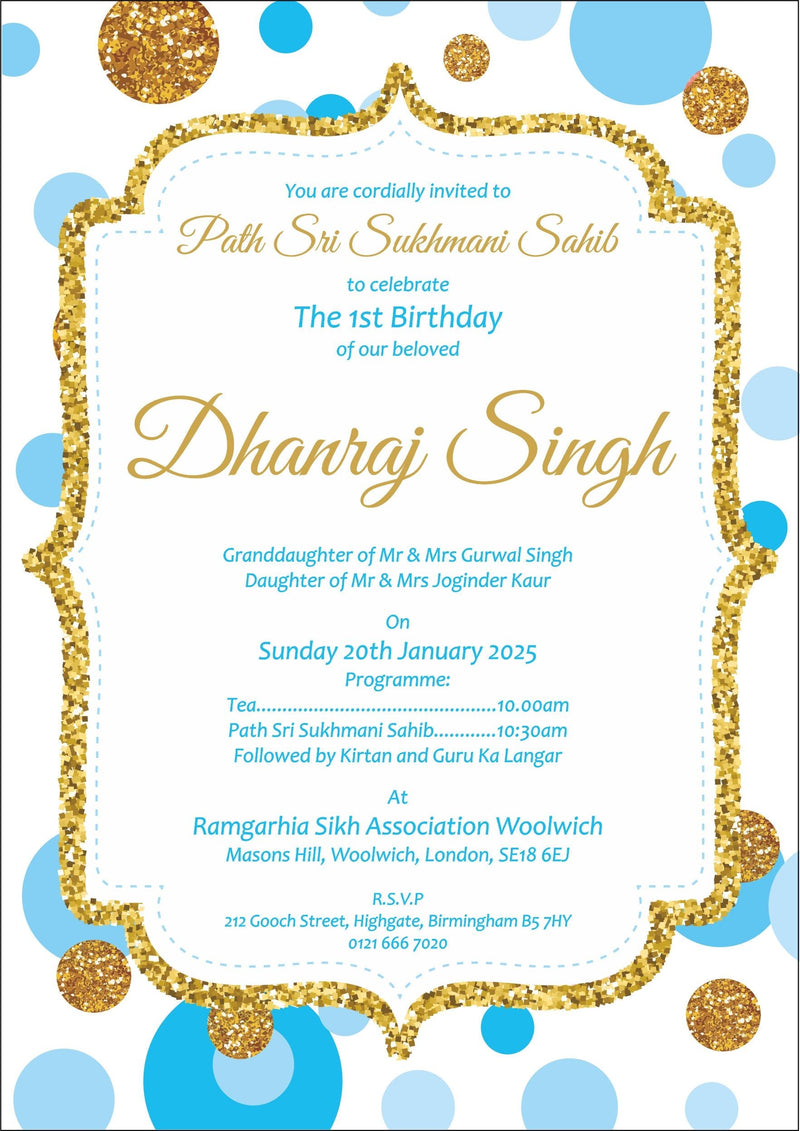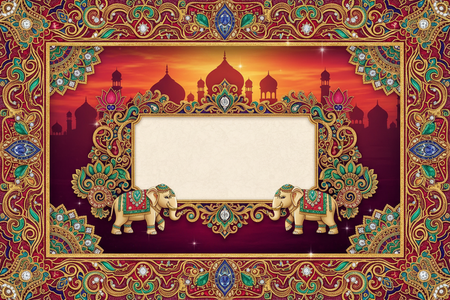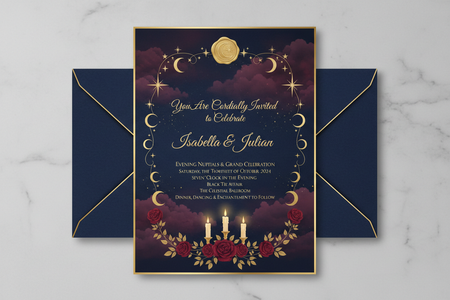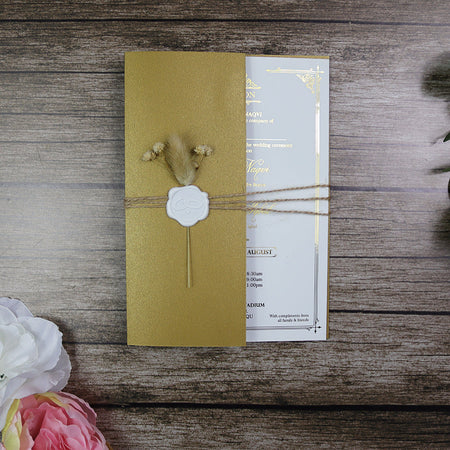Planning a Sikh wedding or religious event? You may have come across the terms Akhand Path and Sukhmani Path, both central to Sikh spiritual practice. At ShadiCards.com, we often get asked about the differences between these two ceremonies—and more importantly, what to include when designing custom invitations for each.
This article breaks down the key distinctions between Akhand Path and Sukhmani Path, their cultural significance, and how your invitation designs should differ for each.
🛕 What is Akhand Path?
An Akhand Path is a continuous, non-stop recitation of the entire Guru Granth Sahib Ji, Sikhism’s sacred scripture. The recital takes approximately 48 hours, often conducted in Gurdwaras or homes and attended by family, friends, and members of the community.
When is it held?
-
Weddings
-
Births
-
Anniversaries
-
Memorials
-
Housewarmings or spiritual milestones
It’s a high-energy, community-driven event filled with langar (communal meals), kirtan (devotional music), and seva (selfless service).
📜 What is Sukhmani Path?
A Sukhmani Path is a recitation of the Sukhmani Sahib, a collection of hymns composed by Guru Arjan Dev Ji. It takes about 1.5 to 2 hours to complete and is often read to bring peace, calm, and spiritual elevation.
When is it held?
-
Pre-wedding blessings
-
During stress or illness
-
Memorials
-
Monthly religious routines
It’s more intimate and reflective, often hosted in homes or smaller Gurdwara gatherings.
🔍 Key Differences at a Glance
| Feature | Akhand Path | Sukhmani Path |
|---|---|---|
| Length | ~48 hours (non-stop) | ~2 hours |
| Scripture Recited | Entire Guru Granth Sahib Ji | Sukhmani Sahib (24 Ashtapadis) |
| Group Size | Large, community-wide | Small to medium gathering |
| Occasion | Life milestones (weddings, etc.) | For peace, healing, and blessings |
| Venue | Gurdwara or home | Gurdwara or home |
| Followed by | Bhog ceremony and langar | Sometimes langar or kirtan |
🪔 Why Invitations Matter for These Events
Many Sikh families now host Akhand Path or Sukhmani Path ceremonies as pre-wedding spiritual events, much like a blessing before the main celebration begins. Sending formal printed invitations adds a touch of tradition, organization, and respect for the event’s sanctity.
At ShadiCards.com, we design culturally respectful and visually elegant invitations for both, whether you want something simple or with gold foil, Ik Onkar calligraphy, or floral borders.
🖋 What to Include in an Akhand Path Invitation
1. Religious Symbols:
-
“Ik Onkar” or “Waheguru Ji Ka Khalsa” at the top
-
Gurmukhi fonts for authenticity
2. Family Names:
-
Hosts (e.g., parents, grandparents)
-
Names of bride/groom (if linked to a wedding)
3. Dates and Times:
-
Start time of the Akhand Path (e.g., Friday morning)
-
Bhog ceremony time (typically 48 hours later, e.g., Sunday morning)
-
Langar timing
4. Venue Details:
-
Gurdwara or home address
-
Parking info or QR code with Google Maps location
5. Dress Code (Optional):
-
Often traditional or respectful attire is preferred
🖋 What to Include in a Sukhmani Path Invitation
1. Religious Greeting:
-
Open with "Ik Onkar" or a verse from Sukhmani Sahib
2. Host Details:
-
Family names or reason for the Path (e.g., birthday blessings, upcoming wedding)
3. Timing:
-
Date and start time (typically morning)
-
Any post-event activity like langar or breakfast
4. Venue:
-
Location (Gurdwara or home)
-
Directions or QR code
5. Optional Add-ons:
-
RSVP info
-
Message from the family
🖼 Design Trends for Akhand Path & Sukhmani Path Invitations
Traditional Styles
-
Cream or ivory backgrounds
-
Gold foil or embossed motifs
-
Red and maroon borders (symbolic in Sikh culture)
Modern Styles
-
Minimalist typography
-
Pastel palettes
-
Floral or watercolour patterns
-
QR codes linking to full event schedules
Language Options
We offer cards in:
-
Punjabi (Gurmukhi)
-
English
-
Dual-language layouts
📈 Which Is More Common?
In the context of weddings, Akhand Path invitations are more widely requested. Many Sikh couples or their families host this event to seek blessings for the new chapter ahead. The community-oriented nature and ceremonial langar afterward make it a widely attended event.
Sukhmani Path, though spiritually powerful, is more private and held for peace and personal reflection. It's less common as a large invitation-led event unless paired with a celebration.
However, both are gaining popularity in diaspora communities in the UK, where families are reconnecting with tradition and adding religious blessings to their wedding timelines.
📦 Akhand & Sukhmani Path Stationery Options at ShadiCards.com
-
Flat Invitations (simple and elegant)
-
Foiled Invitations (luxury touch)
-
Folded Cards (space for full schedules)
-
Matching Envelopes with printed addresses
-
QR Code Integration for Google Maps or RSVP
We also offer matching signage, event programs, and personalised inserts for guests who may be new to Sikh customs.
🕰 When to Send Invitations
-
Akhand Path Invites: 3–5 weeks in advance
-
Sukhmani Path Invites: 2–3 weeks in advance
-
Always order 10–15 extras for last-minute additions
💬 Final Thoughts
Whether you're inviting 300 guests to an Akhand Path or 30 to a quiet Sukhmani Path, your invitation sets the tone. At ShadiCards.com, we honour Sikh traditions while offering contemporary designs that resonate with today’s couples.
🎨 Let us help you create the perfect invitation suite with the right wording, symbolism, and elegance for your spiritual event.
Explore our Sikh event stationery here 👉 ShadiCards.com
Need help designing your invite? 👉 Contact Our Team






